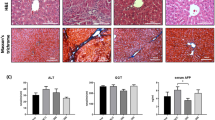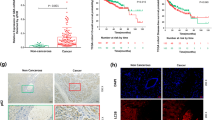Abstract
Clinical efficacy of current therapies for hepatocellular carcinoma (HCC) treatment is limited. Indole-3-acetic acid (IAA) is non-toxic for mammalian cells. Oxidative decarboxylation of IAA by horseradish peroxidase (HRP) leads to toxic effects of IAA. The purpose of this study was to investigate the effects of a novel gene-targeted enzyme prodrug therapy with IAA on hepatoma growth in vitro and in vivo mouse hepatoma models. We generated a plasmid using adenovirus to express HRP isoenzyme C (HRPC) with the HCC marker, alpha-fetoprotein (AFP), as the promoter (pAdv-AFP-HRPC). Hepatocellular cells were infected with pAdv-AFP-HRPC and treated with IAA. Cell death was detected using MTT assay. Hepatoma xenografts were developed in mice by injection of mouse hepatoma cells. The size and weight of tumors and organs were evaluated. Cell death in tumors was assessed using hematoxylin and eosin-stained tissue sections. HRPC expression in tissues was detected using Reverse Transcriptase-Polymerase Chain Reaction. IAA stimulated death of hepatocellular cells infected with pAdv-AFP-HRPC, in a dose- and time-dependent manner, but not in control cells. Growth of hepatoma xenografts, including the size and weight, was inhibited in mice treated with pAdv-AFP-HRPC and IAA, compared with that in control group. pAdv-AFP-HRPC/IAA treatment induced cell death in hepatoma xenografts in mice. HRPC gene expressed only in hepatoma, but not in other normal organs of mice. pAdv-AFP-HRPC/IAA treatment did not cause any side effects on normal organs. These findings suggest that pAdv-AFP-HRPC/IAA enzyme/prodrug system may serve as a strategy for HCC therapy.
This is a preview of subscription content, access via your institution
Access options
Subscribe to this journal
Receive 12 print issues and online access
$259.00 per year
only $21.58 per issue
Buy this article
- Purchase on Springer Link
- Instant access to full article PDF
Prices may be subject to local taxes which are calculated during checkout





Similar content being viewed by others
References
El-serag HM, Rudolph KL . Hepatocellular carcinoma: epidemiology and molecular carcinogenesis. Gastroenterology 2007; 132: 2557–2576.
Yuen MF, Hou JL, Chutaputti A . Epidemiology of hepatocellular carcinoma in Asia-Pacific region. J Gastroenterol Hepatol 2009; 24: 346–353.
Lodato F, Mazzella G, Festi D . Hepatocellular carcinoma prevention: a worldwide emergence between the opulence of developed countries and the economic contraints of developing nations. World J Gastroenterol 2006; 12: 7239–7249.
Hainaut P, Boyle P . Curbing the liver cancer epidemic in Africa. Lancet 2008; 371: 367–368.
Gomaa AL, Khan SA, Toledano MB, Waked I, Taylor-Robinson SD . Hepatocellular carcinoma: epidemiology, risk factors and pathogenesis. World J Gastro 2008; 14: 4300.
Herath NI, Leggett BA, Macdonald GA . Review of genetic and epigenetic alterations in hepatocarcinogenesis. J Gastro Hepato 2006; 21: 15–21.
Koorey D . Hepatocellular carcinoma: prevention, detection and treatment in the real world. Intern med J 2007; 37: 513–515.
Schafer DF, Sorrell MF . Hepatocellular carcinoma. Lancet 1999; 353: 1253–1257.
Brenner MK, Rill DR, Moen RC, Krance RA, Mirro J, Anderson WF et al. Gene-marking to trace origin of relapse after autologous bone-marrow transplantation. Lancet 1993; 341: 85–86.
Blaese RM, Culver KW, Miller AD, Carter CS, Fleisher T, Clerici M et al. T lymphocyte -directed gene therapy for ADA-deficiency SCID: initial trial results after 4 years. Science 1995; 270: 475–480.
Dach GU, Hunt MA, Syddoll S, Singleton DC, Patterson AV . Bystander or no bystander for gene directed enzyme prodrug therapy. Molecules 2009; 14: 4517–4545.
Greco O, Rossiter S, Kanthou C, Folkes LK, Wardman P, Tozer GM et al. Horseradish peroxidase-mediated gene therapy:choice of prodrugs in oxic and anoxic tumor conditions. Mol Cancer Therapeut 2001; 1: 151–160.
Greco O, Dachs GU, Wardman P, Folkes LK, Chaplin DJ . Development of an enzyme/prodrug combination for gene therapy of cancer. Proc Am Assoc Cancer Res 1999; 40: 478.
Folkes LK, Wardman P . Oxidative activation of indole-3-acetic acids to cytotoxic species—a potential new role for plant auxins in cancer therapy. Biochem Pharmacol 2001; 6: 129–136.
Mirsky LA, Diengott D . Hypoglycemic action of indole-3-acetic acid by mouth in patients with diabetes mellitus. Proc Soc Exp Biol Med 1956; 93: 109–110.
Folkes LK, Candeias LP, Wardman P . Towards targeted “oxidation therapy” of cancer: peroxidase-catalyzed cytotoxicity of indole -3-acetic acids. Int J Raduat Oncol Biol Phys 1998; 42: 917–920.
Pires de Melo M, Pithon Curi TC, Curi R, Di Mascio P, Cliento G . Peroxidase activity may play a role in the cytotoxic effect of indole acetic acid. Photochem Photobiol 1997; 65: 338–341.
Pires de Melo M, Pithon Curi TC, Miyasaka CK, Palanch AC, Curi R . Effect of indole acetic acid on oxygen metabolism in cultured rat neutrophil. Gen Pharmacol 1998; 31: 573–578.
Kim DS, Jeon SE, Park KC . Oxidation of indole-3-acetic acid by horseradish peroxidase induces apoptosis in G361 human melanoma cells. Cell Signal 2004; 16: 81–88.
Arbuthnot PB, Bralet MP, Le Jossic C, Dedieu JF, Perricaudet M, Brechot C . In vitro and in vivo hepatoma cell-specific expression of a gene transferred with an adenoviral vector. Hum Gene Ther 1996; 7: 1503–1514.
Mawatari F, Tsuruta S, Ido A, Ueki T, Nakao K, Kato Y et al. Retrovirus-mediated gene therapy of hepatocellular carcinoma:selective and enhanced suicide gene expression regulated by human alpha-fetoprotein enhancer directly linked to its promoter. Cancer Gene Ther 1998; 5: 301–306.
Mamie ZL, Elledge SJ . MAGIC, an in vivo genetic method for the rapid construction of recombinant DNA molecules. Nature Genet 2005; 37: 311–319.
Tan R, Li CH, Jiang SJ, Ma LX . A novel and simple method for construction of recombinant adenoviruses. Nucleic Acids Res 2006; 34: e89.
Nakamure H, Kasuya H, Mullen JT, Yoon SS, Chandrasekhar S, Donahue JM et al. Regulation of herpes simplex virus γ(1)34.5 expression and oncolysis of diffuse liver metastases by Myb34.5. J Clin Invest 2002; 109: 871–882.
Fong Y, Cohen AM, Fortner JG, Enker WE, Turnbull AD, Coit DG et al. Liver resection for colorectal metastases. J Clin Oncol 1997; 15: 938–946.
Panis Y, Ribeiro J, Chretien Y, Nordlinger B . Dormant liver metastases: An experimental study. Br J Surg 1992; 79: 221–223.
Gerolami R, Cardoso J, Lewin M, Bralet MP, Sa Cunha A, Clement O et al. Evaluation of HSV-tk gene therapy in rat model of chemically induced hepatocellular carcinoma by intratumoral and intrahepatic artery routes. Cancer Res 2000; 60: 993–1001.
Xiao KC, Jun LZ, Ying C, Xue MS, Pei YL, Jun SL . Targeting gene therapy for hepatocarcinoma cells with the E.coli purine nucleoside phosphorylase suicide gene system directed by a chimeric α-fetoprotein promoter. Cancer Lett 2008; 264: 71–82.
Kim DS, Kim SY, Jeong YM, Jeon SE, Kim MK, Kuon SB et al. Indole-3-acetic acid/horseradish peroxidase-induced apoptosis involves cell sulface CD95 (Fas/Apo-1) expression. Biol Pharm Bull 2006; 29: 1625–1629.
Acknowledgements
We thank Dr Jiajie Hu for helpful discussions and Prof Lixin Ma for providing donor and recipient plasmid. This work was supported by the grant (2009ZX09301-014-1) awarded by National Mega Project on Major Drug Development (People's Republic of China).
Author information
Authors and Affiliations
Corresponding authors
Ethics declarations
Competing interests
The authors declare no conflict of interest.
Rights and permissions
About this article
Cite this article
Dai, M., Liu, J., Chen, DE. et al. Tumor-targeted gene therapy using Adv-AFP-HRPC/IAA prodrug system suppresses growth of hepatoma xenografted in mice. Cancer Gene Ther 19, 77–83 (2012). https://doi.org/10.1038/cgt.2011.65
Received:
Revised:
Accepted:
Published:
Issue Date:
DOI: https://doi.org/10.1038/cgt.2011.65
Keywords
This article is cited by
-
Enzyme prodrug therapy: cytotoxic potential of paracetamol turnover with recombinant horseradish peroxidase
Monatshefte für Chemie - Chemical Monthly (2021)
-
Enzyme/Prodrug Systems for Cancer Gene Therapy
Current Pharmacology Reports (2016)
-
An updated view on horseradish peroxidases: recombinant production and biotechnological applications
Applied Microbiology and Biotechnology (2015)



